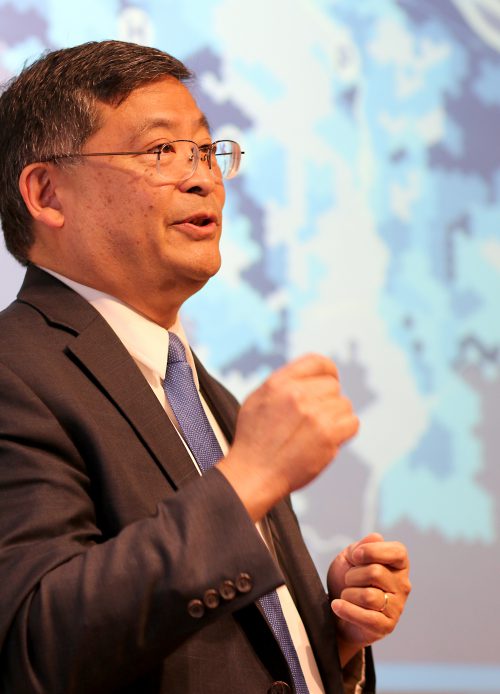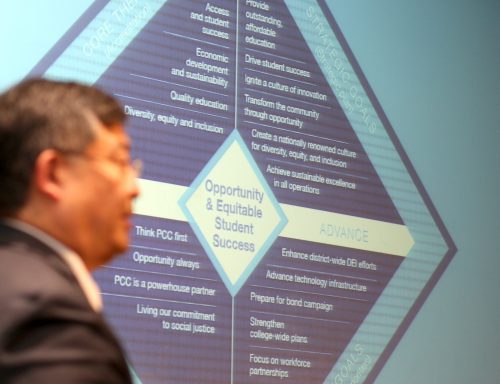This content was published: May 23, 2017. Phone numbers, email addresses, and other information may have changed.
President Mitsui shares his vision for PCC at town hall forums
Photos and story by Katherine Miller
When PCC President Mark Mitsui first arrived seven months ago he vowed to “hit the ground listening.” But recently it was the college’s opportunity to do the listening as the president shared his two-year work plan and vision for PCC in town hall forums at each campus and the CLIMB Center.
At Sylvania Campus, an overflow crowd of faculty, staff and students gathered in the Performing Arts Center Lobby to hear – and ask questions – about the president’s plans to address the challenges PCC faces as it strives to ensure opportunity and equitable student success.

PCC President Mark Mitsui talks about the growing disparities in housing affordability for ethnic groups in Portland and the ramifications for the college.
Mitsui described how one of his priorities in drawing up his work plan was to condense and integrate the myriad institutional goals and initiatives that already exist at PCC.
“When you start adding them up, there are about 25 different strategic goals,” he said. “I don’t know about you, but it’s been my experience that it’s challenging to get organizations to concentrate on more than two or three.”
Mitsui presented a “more digestible and clearer” chart that organizes the goals in four main categories: accreditation, board goals, strategic plan, and key promotional messages. Using a central theme of equitable opportunity and student success, he said he also intends to address the intersection of the different sets of goals and to align key college initiatives.
The equitability theme carried throughout the forum as Mitsui explained how PCC must evolve to meet the challenges wrought by Portland’s robust growth. He said that many residents – especially some communities of color – have been left behind by the current economic recovery and that the resulting income disparities threaten many families in PCC’s service area.
“In our area, the fastest growing income quartiles are the top and the bottom end of the ranges – over $100,000 a year and less than $21,000. The fastest shrinking income quartile is right in the $55,000 to $75,000 a year range,” he said. “The middle class is shrinking in the Portland service area just as it is in the rest of the country.”
Income disparities, plus widespread gentrification and displacement, mean that more students can no longer afford to live in PCC’s service area. And as they are forced to spend more money on housing, it makes it difficult – sometimes impossible – for some to afford higher education.
“What happens if this trend continues?” Mitsui asked. “We can take a look at cities and metropolitan areas where this has already happened. San Francisco, for example. Housing costs there are through the roof. City College of San Francisco used to have a student population of 90,000; it’s now about 60,000. Seattle has a similar kind of dynamic.”
“What happens then if students who traditionally go to community colleges, who see us as the access portal to a better life through education, what if they get pushed out?”
Mitsui said that the skills gap in the Portland area has played a part, too. Although there are many family-wage jobs available, employers often hire from out of state because they say they can’t find qualified local applicants.
In response Mitsui said he will “look at the data in our region and identify where those skill gaps are, what skills are required, and who’s hiring.”
“We want to look at recession-resistant sectors that we know have staying power,” he said. “Those are the jobs people are going to want when they come to us after they’ve been laid off. But looking at the data is a starting point, and getting good data will be important for identifying those opportunities.”
Mitsui identified several other strategies he said can help PCC “double down on better serving those communities that are at risk of being frozen out of the American dream.” These included:
- Build on the work PCC has already done in terms of creating partnerships with employers who are willing to provide paid learning experiences for students as well as scholarships, expertise on curriculum and help with equipment;
- Expand PCC’s efforts to partner with advocates and agencies representing people of color and emerging communities to leverage their resources, connections and advice;
- Align strategic goals with resource allocation (a process that will be discussed more fully at In-Service in the fall, after contract negotiations with staff and faculty are complete and PCC’s portion of the Community College Support Fund has been determined by the state for the 2017-2019 biennium);
- Improve the capacity of PCC to integrate federal benefits for students through partnerships with state agencies and community-based organizations (e.g., HUD housing support or SNAP food support, and explore the expansion of PELL grant access);
- Amplify PCC programs that have a strong track record, such as Career Pathways, Future Connect, Fostering Success, and internally, the Panther Path, which intentionally guides students through their academic journey to ensure success and goal completion;
- Develop measurable indicators in preparation for an accreditation visit next spring by the Northwest Commission on Colleges and Universities;
- Embark on the college’s first comprehensive fundraising campaign;
- Coordinate a successful bond information campaign for the November 2017 election. The bond renewal is geared toward key deferred maintenance, upgraded technology, safety and security, and some renovation projects at PCC beginning in 2020.
Mitsui addressed several questions and comments from the audience on a range of topics, everything from how to support students who are food insecure, to a suggestion that PCC work with employers to offer scholarships for their own employees.
Mitsui said that he has submitted his two-year work plan to PCC’s Board of Directors, but he stressed that he is open to redirecting it as needed based on the feedback he receives at the town hall forums. This communication is key to Mitsui’s mission at PCC.
“We reside in a community context,” he said. “That community, as you know, is changing rapidly. And it’s important for us to change with it.”
